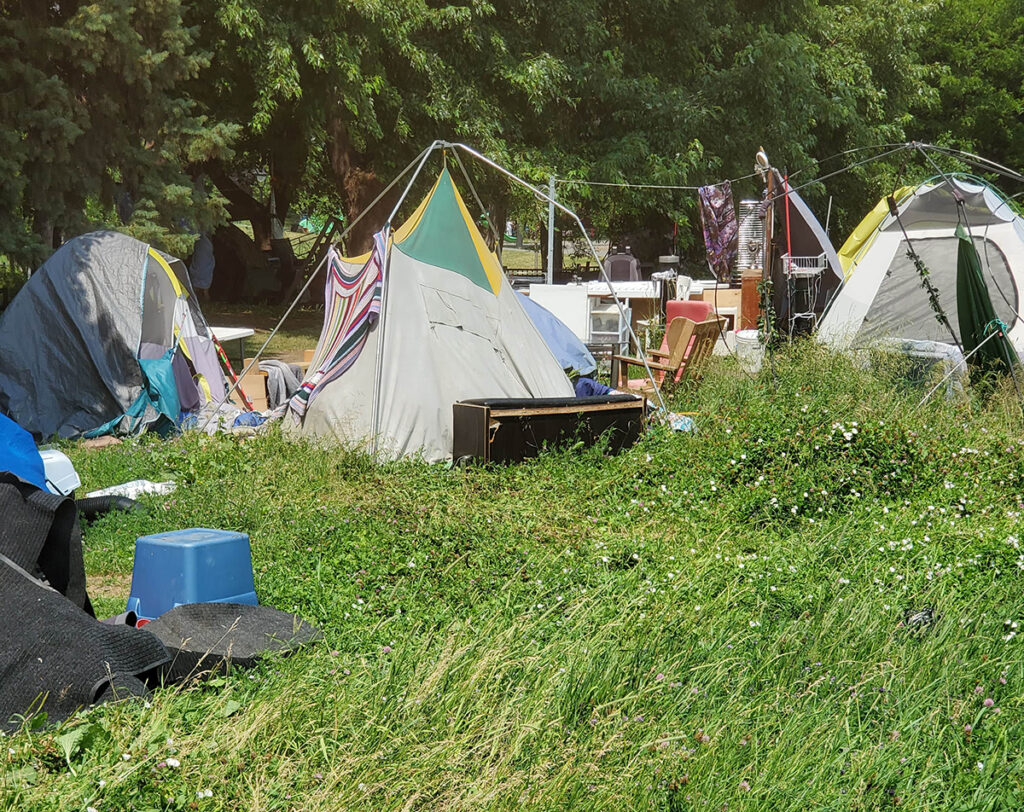
By Colin McGregor
« I’m happy, » says Mélanie, smoking a cigarette. « But I’d be happier with a place to live. »
She’s sitting on the grass under a leaky umbrella on a hot, humid summer day. She’s among those camped on the long, narrow green space along the port in Montreal’s east end, where people with few options pitch their tents every year. This is the famous Notre-Dame encampment. Summer camp for those with little or no other option.
Nearby, a man sleeps in a makeshift hammock. A few meters away, long lines of cars line Notre-Dame Street in Hochelaga-Maisonneuve. On the other side of the road, there are industrial port buildings, then the St. Lawrence River, flowing languidly towards the Atlantic Ocean.
« We’re being taken care of, » says Mélanie. Nurses sometimes drop by, and she meets social workers from Dopamine, a community social services organization in Hochelaga-Maisonneuve that primarily serves drug addicts.
« Everyone is very kind to us. »
But these interactions aren’t enough for everyone.
« What we really need are pharmacists, doctors, and specialized psychiatrists who will help these people with mental health and drug addiction problems, because the situation remains untenable, » Mercier-Hochelaga-Maisonneuve borough mayor Pierre Lessard-Blais tells TVA. Cohabitation is « very difficult » for the neighborhood’s residents, he said.
Every year, the encampment materializes along the same stretch of road. Last year, it extended west of Pie IX Boulevard; this year, it’s limited to east of Pie IX. The number of campers increases, decreases, and then increases again. This year, it seems they have more material goods associated with each tent, but fewer tents. Equipment, clothing, and even bicycles litter the grass.
There are fewer tents this year than last year, twelve dwellings in total. Yet, there are dwellings consisting of three or even four tents packed tightly together, forming a huge dwelling. Larger than some apartments.
That day, another deadline looms: move, or you’ll be displaced, according to the authorities. But no authorities are in sight. Just the hum of traffic, and the sun shining on everyone. The campers seem relaxed.
Does the constant relocation of encampments help resolve the homelessness situation? The position of the Quebec Association for the Promotion of the Health of People Who Use Drugs (AQPSUD) is, in a word: no.

According to Chantal Montmorency, Executive Director of the AQPSUD, « these actions, far from solving the problems, aggravate the vulnerability of those affected by forcing individuals to constantly move, breaking their community support networks, exacerbating mental and physical health problems, and further marginalizing already excluded populations, criminalizing their survival. »
Activists in the community suggest opening a dialogue with campers. According to Dopamine, approximately 70 people were turned away every day from emergency shelters in the encampment area last fall. Hiding the problem from passing drivers on Notre-Dame Street won’t solve anything.


Leave a Reply